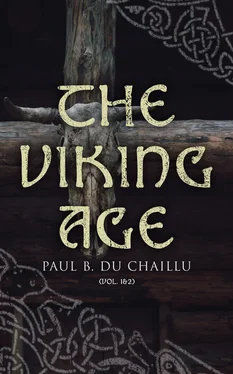Paul B. Du Chaillu - The Viking Age (Vol. 1&2)
Здесь есть возможность читать онлайн «Paul B. Du Chaillu - The Viking Age (Vol. 1&2)» — ознакомительный отрывок электронной книги совершенно бесплатно, а после прочтения отрывка купить полную версию. В некоторых случаях можно слушать аудио, скачать через торрент в формате fb2 и присутствует краткое содержание. Жанр: unrecognised, на английском языке. Описание произведения, (предисловие) а так же отзывы посетителей доступны на портале библиотеки ЛибКат.
- Название:The Viking Age (Vol. 1&2)
- Автор:
- Жанр:
- Год:неизвестен
- ISBN:нет данных
- Рейтинг книги:3 / 5. Голосов: 1
-
Избранное:Добавить в избранное
- Отзывы:
-
Ваша оценка:
- 60
- 1
- 2
- 3
- 4
- 5
The Viking Age (Vol. 1&2): краткое содержание, описание и аннотация
Предлагаем к чтению аннотацию, описание, краткое содержание или предисловие (зависит от того, что написал сам автор книги «The Viking Age (Vol. 1&2)»). Если вы не нашли необходимую информацию о книге — напишите в комментариях, мы постараемся отыскать её.
The Viking Age (Vol. 1&2) — читать онлайн ознакомительный отрывок
Ниже представлен текст книги, разбитый по страницам. Система сохранения места последней прочитанной страницы, позволяет с удобством читать онлайн бесплатно книгу «The Viking Age (Vol. 1&2)», без необходимости каждый раз заново искать на чём Вы остановились. Поставьте закладку, и сможете в любой момент перейти на страницу, на которой закончили чтение.
Интервал:
Закладка:
The gods, it would seem, had it in their power, if not to secure everlasting life, at least to retain perpetual youth, unlike poor Tithonus of the well-known Greek myth. It may not be inappropriate to continue here the legend relating to this. Idun, the wife of Bragi, who was celebrated for his wisdom and eloquence, kept in a box the apples which when the gods felt old age approaching they ate in order that they might keep their youth till Ragnarök.
“Odin, Loki and Hœnir went from home over mountains and uninhabited land, and it was not easy for them to get food. When they came down into a valley they saw a herd of oxen, took one of them and prepared it for the fire. When they thought it was cooked they took it off, but it was not cooked. A second time, after waiting a little, they took it off, and it was not cooked. They considered what might be the cause of this. Then they heard a voice in the tree above them which said that he who sat there caused this. They looked up, and a large eagle sat there. The eagle said: ‘If you will give me my fill of the ox, it shall be cooked.’ They assented, and the bird came slowly down from the tree, sat down on the hearth, and at once gobbled up the four shoulder-pieces of the ox. Loki got angry, took a large pole, raised it, and with all his strength struck the eagle. At the blow the eagle flew into the air. The pole adhered to its body, and the hands of Loki to one end of it. The eagle flew so that Loki’s feet touched the rocks, the stone-heaps and the trees. He thought his hands would be torn from his shoulders. He shouted, eagerly asking the eagle to spare him, but it answered that Loki would never get loose unless he swore to make Idun leave Asgard with her apples. Loki promised this, got loose and went to his companions, and no more tidings are told about their journey till they reached home. At the appointed time Loki enticed Idun to go to a wood out of Asgard by saying he had found apples which she would prefer to her own, and asked her to take her own apples with her to compare them. Thjassi Jötun then came in an eagle’s shape and took Idun and flew away to his abode in Thrymheim. The Asar were much grieved at the disappearance of Idun, and soon became grey-haired and old. They held a Thing and asked each other for news of Idun. The last seen of her was when she walked out of Asgard with Loki. He was brought to the Thing and threatened with death or torture. He got afraid and said he would fetch Idun from Jötunheim, if Freyja would lend him the hawk-skin which she owned. When he got it he flew north to Jötunheim, and one day came to Thjassi Jötun, who was sea-fishing. Idun was alone at home. Loki changed her into a nut, held her in his claws and flew as fast as he could. When the Asar saw the hawk flying with the nut and the eagle pursuing they went to the Asgard-wall and carried thither bundles of plane-shavings. When the hawk flew into the burgh it came down at the wall. The Asar set fire to the plane-shavings, but the eagle could not stop when it lost the hawk, and the fire caught its feathers and stopped it. The Asar were near, and slew Thjassi inside the Asgard-wall, which is a very famous deed. Skadi, his daughter, took helmet and brynja and a complete war-dress, and went to Asgard to avenge her father. The Asar offered her reconciliation and wergild , 77and first that she might choose a husband from among them, not seeing more than their feet. She saw a pair of very beautiful feet, and said: ‘This one I choose; few things can be ugly in Baldr.’ But it was Njörd of Nóatún.” (Later Edda, Bragarœdur, c. 56.)
CHAPTER VI.
ODIN OF THE NORTH.
Table of Contents
The Odin of the North—The forefathers of the English—Their migration from the shores of the Black sea—The geographical knowledge of the Norsemen—Tyrkland the home of Odin—Sigrlami, one of the sons of Odin—Odin establishes his family in the North—Death of Odin in the North—Attributes of Odin—Poetical names of Odin—Sleipnir, the horse of Odin—Odin as a one-eyed man.
In the Norse literature we find Odin referred to not only as a god, but as a hero and leader of men. It is not necessary to believe that any real person of the name of Odin ever existed, but from the frequency with which a migration northwards is mentioned, and from the details with which it is described, it is legitimate to infer that the predecessor of the Norsemen came from the south or south-east of Europe—probably, to judge from literature and archæology combined, from the shores of the Black Sea.
At the time of Odin’s arrival in the North we find not only a country called Gardariki, which is often mentioned in the Sagas, and seems to have adjoined the south-eastern shores of the Baltic, but also the large Scandinavian peninsula and that of Jutland, and the islands and shores of the Baltic, populated by a seafaring people whose tribes had constant intercourse with each other, and, to judge by the finds, seem to have had an identical religion. These people intermarried with the Asar who came north with Odin, and hence arose tribes called half-Risar and half-Troll.
“It is written in old books that Alfheimar 78were north in Gandvik and Ymisland, between it and Hálogaland. And before the Tyrkjar and Asia-men came to the Northern lands, Risar and half-Risar lived there; then the nations (peoples) were much mixed together; the Risar got wives from Mannheimar, and some of them married their daughters there” (Hervarar Saga, ch. i.).
The account given in the Hervarar Saga agrees with that in the Ynglinga Saga, which is important not only as giving an idea of the conception the people of the North had of our world, but as describing the names of the lands and countries mentioned in the earlier Eddas and Sagas.
“The round of the world on which men dwell is much cut by the sea; large seas stretch from the outer sea round the earth into the land. It is known that a sea runs from Njörvasund (Straits of Gibraltar) all the way up to Jorsalaland (the land of Jerusalem). From it a long bay runs north-east, called the Black Sea, which separates the three parts of the world; the part east of it is called Asia, but the one west of it is called Europa by some, and Enea by others. North of the Black Sea is the great or the cold Sweden; some say that Sweden is no smaller than Serkland (the land of Saracens) the great; some say she is as large as Blaland (the land of the blue (black) men) the great. The northern part of Sweden is uninhabited, on account of frost and cold, as the southern part of Blaland is on account of the sun’s burning heat. In Sweden there are many large herads (districts).
There are also many kinds of people and many tongues: there are Asar, Dvergar, and Blamenn (blue (black) men), and many kinds of strange people; there are beasts and dragons wonderfully large. From the north, in mountains which are beyond all settlements, a river springs that flows through Sweden; its right name is Tanais; it was in old times called Tanakvísl, 79or Vana-kvísl; it flows into the Black Sea. The land round Vanakvísl was then called Vanaland or Vanaheim (home or world of the Vanir). This river 80separates the two-thirds of the world; east of it is Asia, and West of it is Europa” (Ynglinga Saga, 1).
“A large mountain ridge runs from north-east to south-west; it separates Sweden the Great 81from other lands. South of the mountain, not far off, is Tyrkland; there Odin owned a great deal of land. At that time the chiefs of the Rómverjar (Romans) went widely about the world and underlaid (conquered) all nations; and many chiefs on that account left their lands. As Odin was foreknowing and skilled in witchcraft he knew that his descendants would live in the northern part of the world. Then he set his brothers Vili and Vé to rule Asgard; he left, and all the Díar with him, and many folk. First he went westwards to Gardaríki, then southwards to Saxland. He had many sons; he became owner of land at many places in Saxland, and left his sons to defend Saxland. Then he went northwards to the sea and settled on an island; that place is now called Odinsey (Odin’s island) in Fjón (Fýen). Then he sent Gefjon 82northwards across the Sound to discover lands; she came to Gylfi, and he gave her one plough-land. Then she went to Jötunheim and there got four sons by a Jötun; she changed them into oxen, and harnessed them to the plough, and drew the land out to sea, and westwards, opposite to Odinsey, and the land is called Selund (Zealand); she afterwards lived there. Skjöld, a son of Odin, married her; they lived at Hleidra (Leire). There is a lake or sea called Lög (Mälaren). The fjords in the Lög lie as the nesses in Selund. When Odin heard that Gylfi’s land was good he went there, and he and Gylfi made an agreement, for Gylfi thought he had not strength enough to withstand the Asar. Many devices and spells did Odin and Gylfi use against each other, and the Asar always got the better of them. Odin took up his abode at the Lög (Mälaren), which is now called the old Sigtúnir; there he made a great temple and sacrificed according to the custom of the Asar. He gave abodes to the temple-priests; Njörd lived at Nóatún, Frey at Uppsalir, Heimdall at Himinbjörg, Thor at Thrúdvang, Baldr at Breidablik; he gave good abodes to them all” (Ynglinga, c. 5).
Читать дальшеИнтервал:
Закладка:
Похожие книги на «The Viking Age (Vol. 1&2)»
Представляем Вашему вниманию похожие книги на «The Viking Age (Vol. 1&2)» списком для выбора. Мы отобрали схожую по названию и смыслу литературу в надежде предоставить читателям больше вариантов отыскать новые, интересные, ещё непрочитанные произведения.
Обсуждение, отзывы о книге «The Viking Age (Vol. 1&2)» и просто собственные мнения читателей. Оставьте ваши комментарии, напишите, что Вы думаете о произведении, его смысле или главных героях. Укажите что конкретно понравилось, а что нет, и почему Вы так считаете.












